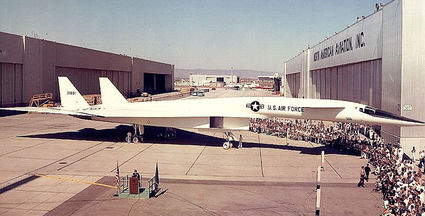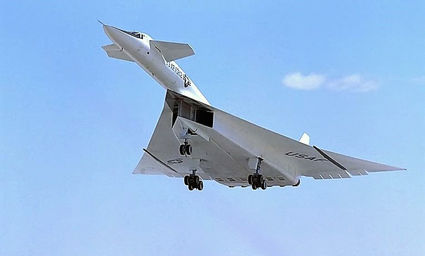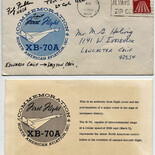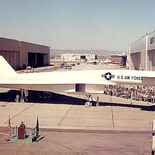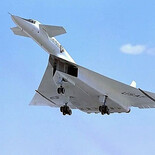The legendary XB-70 Valkyrie
Short Flights
We miss our family friend, Fitzhugh "Fitz" Fulton Jr., who passed away Feb. 4, 2015. He was born in Blakely, Ga. on June 6, 1925. I feel privileged to have a copy of his autobiography, "Father of the Mother Planes." The book covers his extraordinary aviation career that spanned more than four decades.
While in the U.S. Air Force, he flew in the Berlin Airlift and Korean War, tested the Air Force's newest bombers, launched every 'X-Plane' from the X-1 to the X-15 and flew the Mach 2 B-58 Hustler (his classic ride) and triplesonic XB-70 Valkyrie.
After retiring from the Air Force, he flew for NASA piloting aircraft such as the YF-12 and 747 Shuttle Carrier Aircraft. After leaving NASA, he became a test pilot for Scaled Composites at Mojave Airport, where he hangered his personal aircraft.
Fitz flew some of my all-time favorite airplanes, including the North American Aviation XB-70 and Convair B-58 Hustler.
Fitz was the pilot of the XB-70 Valkyrie on its last flight from Edwards AFB, Calif. to Wright-Patterson AFB Ohio, on Feb. 4, 1969. I still treasure the XB-70A First Flight envelop he sent to my Dad with the word "First" crossed out and above it Fitz wrote the word, "Last."
Flying at altitudes over 70,000-feet at Mach 3.08, (over 2,000 miles per hour), the Valkyrie had a turning radius of 9 miles. Its wingtips could be dipped during supersonic flight, allowing the Valkyrie to "ride" its own shockwave. What a machine! The XB-70 was designed and built by North American Aviation in Palmdale, Calif. (Plant 42) and I was lucky enough to attend the rollout ceremonies in 1964. I still have the slides in my archives somewhere.
The U.S. Air Force wanted new technology advances, so research and development of the XB-70 actually began in 1955 and this aircraft was supposed to replace the B-52! (Note: April 15 this year marked the 65th Anniversary of the first flight of the B-52). As always there was competition during the design phase, this time between Boeing and North American.
The Air Force requirement was for a Mach 3, high-altitude, long-range bomber capable of carrying nuclear and conventional weapons and North American Rockwell won the contract.
The XB-70 had a long fuselage with a canard, or horizontal stabilizer, mounted just behind the crew compartment. Fitz told me that the cockpit where he sat was 70-feet in front of the nose wheel! Can you imagine taxiing that?
The XB-70 had a length of 196 feet, a height at the tail of 31 feet, and an estimated maximum gross weight of 521,000 pounds. It had a crew of four: pilot, copilot, bombardier, and defensive systems operator.
The delta wing had a span of 105 feet with six General Electric turbojet engines (J93-GE 3), each in the 30,000-lb thrust class, with two large rectangular inlet ducts providing two-dimensional airflow, side by side in a large pod underneath the fuselage. The wing was swept at about 65.5 degrees, and the wing tips were folded down hydraulically 25 degrees in flight and to 65 degrees to improve lateral-directional stability at the aircraft's supersonic speeds of up to Mach 3.
At Mach 3 the Valkyrie was designed to ride its own shock wave. The large canard near the front of the fuselage had a span of 28 feet, 10-inches and was used for stability. In addition to its sharply swept delta wings, the XB-70s had two large vertical tails. The airplane had two windshields: a moveable outer windshield was raised for high-speed flight to reduce drag and lowered for greater visibility during takeoff and landing.
Data collected during the flight testing of the B-70 was to be used for an SST (Supersonic Transport) that was never developed by the U.S.
Fitz calmly described an incredible XB-70 story to my son, Mark, about fifteen years ago at Mojave Airport. It was May 7, 1965 and was AV/1's 12th flight, with Al White and Fitz Fulton at the controls. Traveling at Mach 2.58 (almost 1700mph!), a 'thump' was heard in the cockpit, soon followed by a number of engine-related alarms! Engines three, four, five, and six were shut down right away. As the chase planes caught up, they reported that the horizontal splitter (the very apex of the delta wing) had torn away. For the final approach, Fitz restarted number five engine to provide some thrust from the right side, and the XB-70 landed on the long lakebed without major incident. All six engines, nearly one-sixth of the 38 ever built, were destroyed beyond repair.
Upon landing it was obvious that the inboard leading edge of the wing was missing. It had been ingested into the air intake and fodded all of the engines! Even though he managed to get one engine restarted, it wouldn't advance above an idle.
As if all of that wasn't enough to go wrong, when Fitz called control to report their dilemma, the generator fell off-line and all electrical power failed. It was a miracle that they actually were able to land safely!
Beautiful memories of a beautiful aircraft and a wonderful gentleman.
See you on our next flight!


